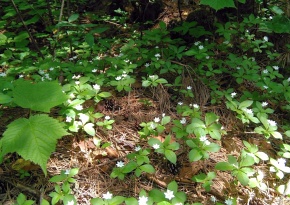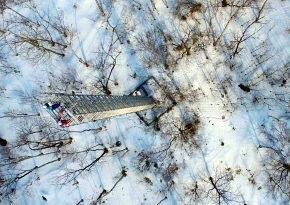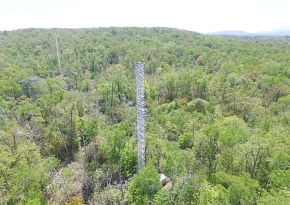Topics from FFPRI FluxNet
Article: 2017-08-24
Dynamics of the forest carbon budget before and after a heavy wind damage
Tower flux observation captures ever-changing forest carbon budget.
In September 2004, a typhoon surged toward Japan's northernmost main island Hokkaido and strong wind attacked to the south western Hokkaido district. During the storm, the maximum instantaneous wind speed of 50.2 ms-1 observed in the Sapporo Meteorological Observatory by JMA updated the record. The strong wind heavily damaged forests, and many white birch and Mizunara-oak trees uprooted or snapped off in the Sapporo tower site.
After the disturbance, the annual forest carbon budget changed from absorption to release and the release still persists in 2012, 8 years after the event. In regard to clarify the mechanisms causing such a long-lasting behavior, the validatiion by forest ecosystem modeling is conducting with greater urgency in Sapporo site, as well as the secure in-situ observations including the continious tower flux monitoring and biomass survey.

by long-term tower-flux monitoring.
Sapporo (SAP) Site Information 
Article: 2017-07-07
Existence of hot spots of α-pinene emission on the floor of a red pine forest in spring

The biogenic volatile organic compounds (BVOC) represented by α-pinene are well known aromatic volatile substances (phytoncides) of forest. BVOC are also a precursor of ozone and secondary organic aerosol (SOA) in atmospheric chemistry. To reveal the mechanism of produce of ozone and SOA in forest ambient, the FFPRI FluxNet started observation of the BVOC using the existing CO2 monitoring tower network.
To evaluate the spatial variations in soil BVOC emissions, the study was conducted on the floor of a Japanese red pine forest using the soil chamber method. The large spatial variation caused by the distribution of resin existed particularly during spring.
Fujiyoshida (FJY) Site Information 
Article: 2017-05-19
Aerial view of the Sapporo (SAP) site by UAV: phantom 3 in early & late spring, 2017
Test flights for grasping canopy conditions and atmospheric properties have been conducted above the Japanese white birch forest.



 Top of Page
Top of Page